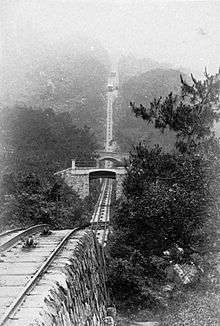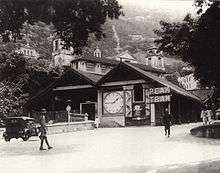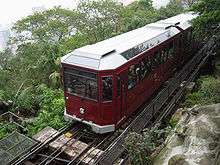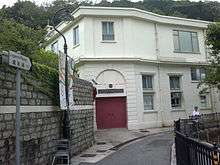Peak Tram
The Peak Tram is a funicular railway in Hong Kong, which carries both tourists and residents to the upper levels of Hong Kong Island. Running from Garden Road Admiralty to Victoria Peak via the Mid-Levels, it provides the most direct route and offers good views over the harbour and skyscrapers of Hong Kong.
 | |||||||||||||||||||||||||||||||||||||||||||||||||||||||||||||||||||||||||||||||||||||||||||||||||||||||||||||||||||||||||||||
| Overview | |||||||||||||||||||||||||||||||||||||||||||||||||||||||||||||||||||||||||||||||||||||||||||||||||||||||||||||||||||||||||||||
|---|---|---|---|---|---|---|---|---|---|---|---|---|---|---|---|---|---|---|---|---|---|---|---|---|---|---|---|---|---|---|---|---|---|---|---|---|---|---|---|---|---|---|---|---|---|---|---|---|---|---|---|---|---|---|---|---|---|---|---|---|---|---|---|---|---|---|---|---|---|---|---|---|---|---|---|---|---|---|---|---|---|---|---|---|---|---|---|---|---|---|---|---|---|---|---|---|---|---|---|---|---|---|---|---|---|---|---|---|---|---|---|---|---|---|---|---|---|---|---|---|---|---|---|---|---|
| Locale | Hong Kong | ||||||||||||||||||||||||||||||||||||||||||||||||||||||||||||||||||||||||||||||||||||||||||||||||||||||||||||||||||||||||||||
| Transit type | Funicular railway | ||||||||||||||||||||||||||||||||||||||||||||||||||||||||||||||||||||||||||||||||||||||||||||||||||||||||||||||||||||||||||||
| Number of stations | 6 | ||||||||||||||||||||||||||||||||||||||||||||||||||||||||||||||||||||||||||||||||||||||||||||||||||||||||||||||||||||||||||||
| Daily ridership | About 17,000 | ||||||||||||||||||||||||||||||||||||||||||||||||||||||||||||||||||||||||||||||||||||||||||||||||||||||||||||||||||||||||||||
| Operation | |||||||||||||||||||||||||||||||||||||||||||||||||||||||||||||||||||||||||||||||||||||||||||||||||||||||||||||||||||||||||||||
| Began operation | 30 May 1888 | ||||||||||||||||||||||||||||||||||||||||||||||||||||||||||||||||||||||||||||||||||||||||||||||||||||||||||||||||||||||||||||
| Operator(s) | The Peninsula Hotels | ||||||||||||||||||||||||||||||||||||||||||||||||||||||||||||||||||||||||||||||||||||||||||||||||||||||||||||||||||||||||||||
| Technical | |||||||||||||||||||||||||||||||||||||||||||||||||||||||||||||||||||||||||||||||||||||||||||||||||||||||||||||||||||||||||||||
| System length | 1.365 kilometres (0.848 mi) | ||||||||||||||||||||||||||||||||||||||||||||||||||||||||||||||||||||||||||||||||||||||||||||||||||||||||||||||||||||||||||||
| Track gauge | 1,520 mm (4 ft 11 27⁄32 in) Russian gauge | ||||||||||||||||||||||||||||||||||||||||||||||||||||||||||||||||||||||||||||||||||||||||||||||||||||||||||||||||||||||||||||
| |||||||||||||||||||||||||||||||||||||||||||||||||||||||||||||||||||||||||||||||||||||||||||||||||||||||||||||||||||||||||||||
The Peak Tram is owned and operated by Hongkong and Shanghai Hotels (HSH), the owner of Hong Kong's Peninsula Hotel along with other properties. The line, along with HSH's Peak Tower leisure complex at the line's summit, is promoted using the brand The Peak.[1][2]
The Peak is currently being upgraded to have longer cars and wider platforms. Since 22 July 2019, the funicular railway has been reopened for service, using a temporary platform for Garden Road.[3] In the absence of tram service, the New World First Bus non-stop route X15 may be operated between Admiralty and the Peak in addition to the regular bus and minibus services, and other temporary traffic measures may be taken.[4][5]
Route

The Peak Tram's route from Central district to Victoria Peak covers a distance of about 1.4 kilometres (0.87 mi) and an elevation of just under 400 metres (1,312 ft). The line has two pronounced curves, one to the left immediately after leaving the lower terminus, and the other to the right in the upper half of the ascent. The gradient also varies considerably throughout the ascent. It is a single track route and a passing loop, with two trams.
The lower terminus station, Garden Road, is located on Garden Road near St. John's Cathedral. The original station was incorporated into St. John's Building, an office tower, with the tram terminus at the ground level. The station comprises a single track, with platforms on both sides. One platform is used for boarding, the other for exiting the tram.
The upper terminus, The Peak, is located below the Peak Tower shopping and leisure complex at Victoria Gap, some 150 meters below the summit of Victoria Peak. The station has the same arrangement of boarding and alighting platforms as the lower terminus. The haulage and control equipment for the funicular is located in a basement below the station.
There are also four intermediate stops, each of which is a request stop consisting of a single stepped platform and a shelter:
- Kennedy Road. Located on Kennedy Road, named after Arthur Edward Kennedy, a former Governor of Hong Kong.
- MacDonnell Road. Located on MacDonnell Road, named after Richard Graves MacDonnell, a former Governor of Hong Kong; depot storing historic car is next to the stop.
- May Road. Located on May Road, named after Francis Henry May, a former Governor of Hong Kong.
- Barker Road. Located on Barker Road, named after George Digby Barker, a former military commander and acting administrator of Hong Kong.
History

| Peak Tram | |||||||||||
|---|---|---|---|---|---|---|---|---|---|---|---|
| Traditional Chinese | 山頂纜車 | ||||||||||
| |||||||||||
In 1881 Alexander Findlay Smith first put the project of a Peak Railway into shape and presented a petition for a concession to the governor of Hong Kong. The necessary legislation was passed two years later.
Findlay Smith did not approach the project rashly. Travelling extensively in Europe and America, he made himself conversant with nearly every existing method of railway employed for mountain ascent — San Francisco, Scarborough, Rigi, Monterey, Lucerne, the Rhine, Mount Vesuvius — and returned to Hong Kong thoroughly convinced of the feasibility of his idea. The actual construction was begun in September 1885 and in May 1888 the line was officially opened.[6]
Smith's business partner, N. J. Ede, owned and lived in the house next to the Upper Terminus, originally named Dunheved, which they converted into the original Peak Hotel.
It took three years to build the Peak Tram. Most of the heavy equipment and rails needed for the construction were hauled uphill by the workers with no mechanical support.[7] As a revolutionary new form of transport for Asia at the time, the tramway was considered a marvel of engineering upon its completion.[7] A wooden structure was built for the terminal.[7] According to photographs, the Garden Road terminus was originally an unadorned building, a large clock face was added to the edifice probably between the 1910s and 1920s.
The Peak Tram was opened for public service on 28 May 1888 by the then governor Sir George William des Voeux.[7] As built, the line used a static steam engine to power the haulage cable. It was at first used only for residents of Victoria Peak. Despite that, it carried 800 passengers on its first day of operation, and about 150,000 in its first year,[7] transported in the line's original wooden-bodied cars.[8] The tram's existence accelerated the residential development of Victoria Peak and the Mid Levels.
From its opening in 1888 until 1926, the Peak Tram divided into three classes:
- First Class: British colonial officials and residents of Victoria Peak
- Second Class: British military and Hong Kong Police Force personnel
- Third Class: Other people and animals
The initial round trip charges, HKD 30 cents (First Class), 20 cents (Second Class) and 10 cents (Third Class),[8] had risen 50 per cent by 1926.
From 1908 to 1949, the first two seats in the front of the tram were reserved for the governor of Hong Kong, to which was attached a bronze plaque reading: "This seat is reserved for His Excellency the Governor". The seats were not available to ordinary passengers until two minutes before departure.
In the course of its history, the tram has been a victim of two natural disasters, caused by floods from heavy rainfall, which washed away steep sections of the track between Bowen Road and Kennedy Road. The first was in 1899, and the second occurred on 12 June 1966.[7]
In 1926, the steam engine was replaced by an electric motor. On 11 December 1941, during the Battle of Hong Kong, the engine room was damaged in an attack. Services were not resumed until 25 December 1945, after the end of the Japanese occupation of Hong Kong.[8]
In 1956, the Peak Tram was equipped with a new generation of lightweight metal-bodied cars, each of which seated 62 passengers. Unusually for a funicular line, three such cars were provided, only two of which were in use at any one time. The third spare car was kept in a car shed near Kennedy Road station.[8]
The system was comprehensively rebuilt in 1989 by the Swiss company, Von Roll, with a new track, a computerized control system, and two new two-car trams with a capacity of 120 passengers per tram. By the time of the handover in 1997, the system carried some 2 million passengers annually.[7] Today, more than 4 million people ride the Peak Tram annually, or an average of over 11,000 every day.[8]
Of prior rolling stock, only two 1956 fourth generation all-aluminum cars survive; one is displayed at the upper terminal, and another can be seen on a disused spur track after leaving Garden Road. No earlier cars exist, but a replica of the first car is displayed in the Peak Tram Historical Gallery.
Statistics

The Peak Tram is a funicular railway, with the following technical parameters:[9]
- Length: 1,364 metres (4,475 ft)
- Height: 368 metres (1,207 ft)
- Maximum Steepness: 48 %
- Track Gradient: 4–27 degrees
- Cars: 2 two-car train sets
- Car Builder: Gangloff AG,[10] Switzerland
- Capacity: 120 passengers per train set
- Configuration: Single track with passing loop
- Journey time: average 4.9 minutes
- Maximum speed: 6 metres per second (19.69 ft/s; 13.42 mph)
- Track gauge: 1,520 mm (4 ft 11 27⁄32 in) Russian gauge
- Traction: Electric
No. 1 Lugard Road

The building at No. 1 Lugard Road, located next to the Peak Tower and The Peak Lookout, was built about 1927 by The Peak Tramways Co. Ltd. as a workshop, with an additional floor added in 1953 to provide a flat for the General Manager of Company. The building is still owned and used by the Peak Tramways Company.[11] It is a Grade III historic building since 2010.[12]
See also
- List of buildings and structures in Hong Kong
- List of funicular railways
- Peak Reservation Ordinance
- Tourism in Hong Kong
- Transport in Hong Kong
References
- "The Hongkong and Shanghai Hotels - Peak Tramways". The Hongkong and Shanghai Hotels, Limited. Archived from the original on 16 March 2006. Retrieved 13 March 2007.
- "The Peak". The Peak. Archived from the original on 6 March 2007. Retrieved 13 March 2007.
- "The Peak Tram Upgrade Project | THE PEAK HONG KONG". www.thepeak.com.hk. Retrieved 2019-08-12.
- Cheung, Jane (23 April 2019). "Traffic alert as Peak Tram shuts - The Standard". The Standard. Retrieved 23 April 2019.
- "Peak Tram suspends service to boost capacity". EJ Insight. 23 April 2019. Retrieved 23 April 2019.
- 1930s Booklet "The Shortcut to Beauty, Hong Kong's Peak Tram" circa 1930
- Cavaliero, Eric (1997-07-24). "Grand old lady to turn 110". The Standard. Hong Kong. Archived from the original on 2008-08-01. Retrieved 2017-04-05.
- "Peak Tram History". The Peak Hong Kong. Archived from the original on 20 February 2007. Retrieved 13 March 2007.
- "Peak Tramway". Funiculars.net. Retrieved 13 March 2007.
- Gangloff AG
- Brief Information on Proposed Grade 3 Items, Item #886 Archived 2012-03-21 at the Wayback Machine.
- List of the Historic Buildings in Building Assessment (as of 21 September 2012) Archived September 22, 2013, at the Wayback Machine